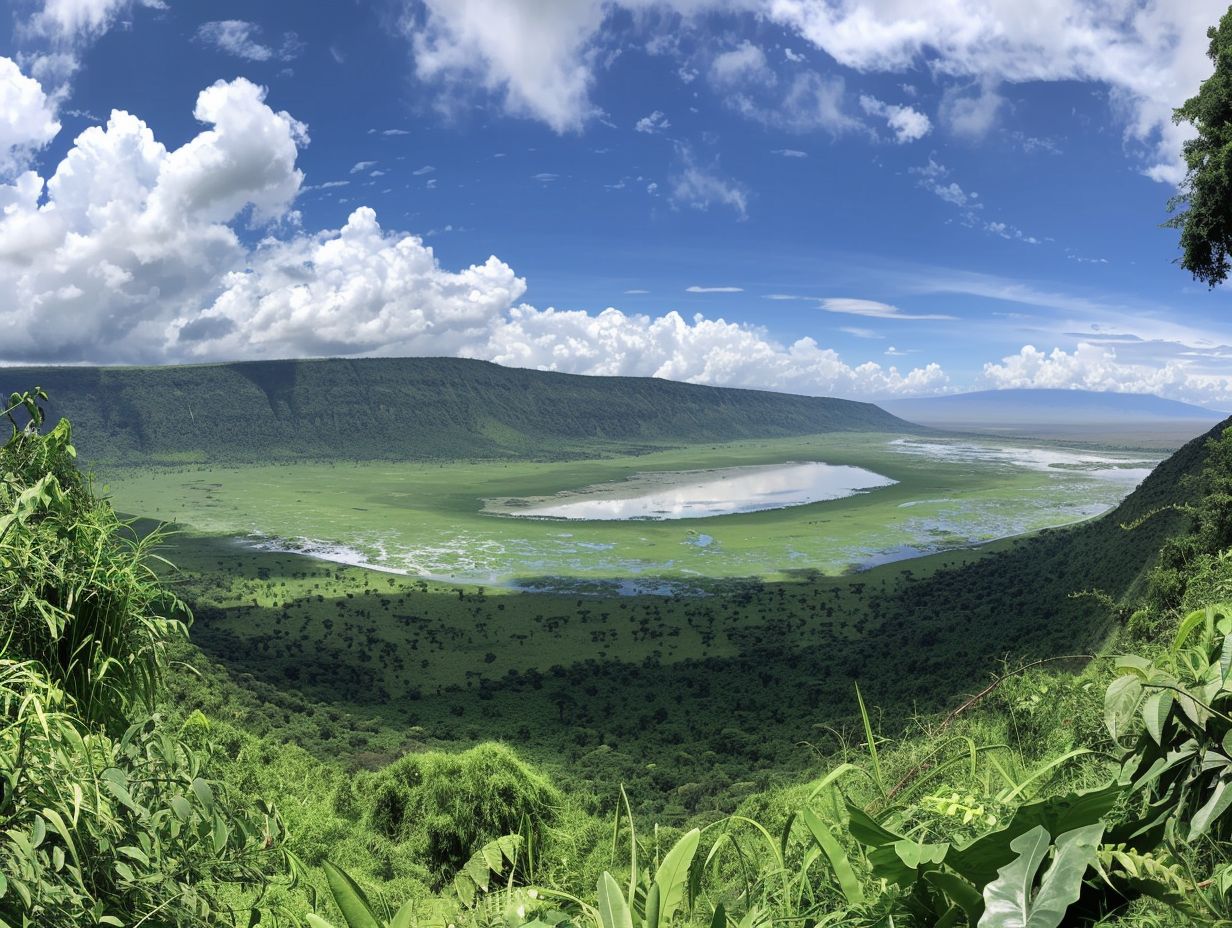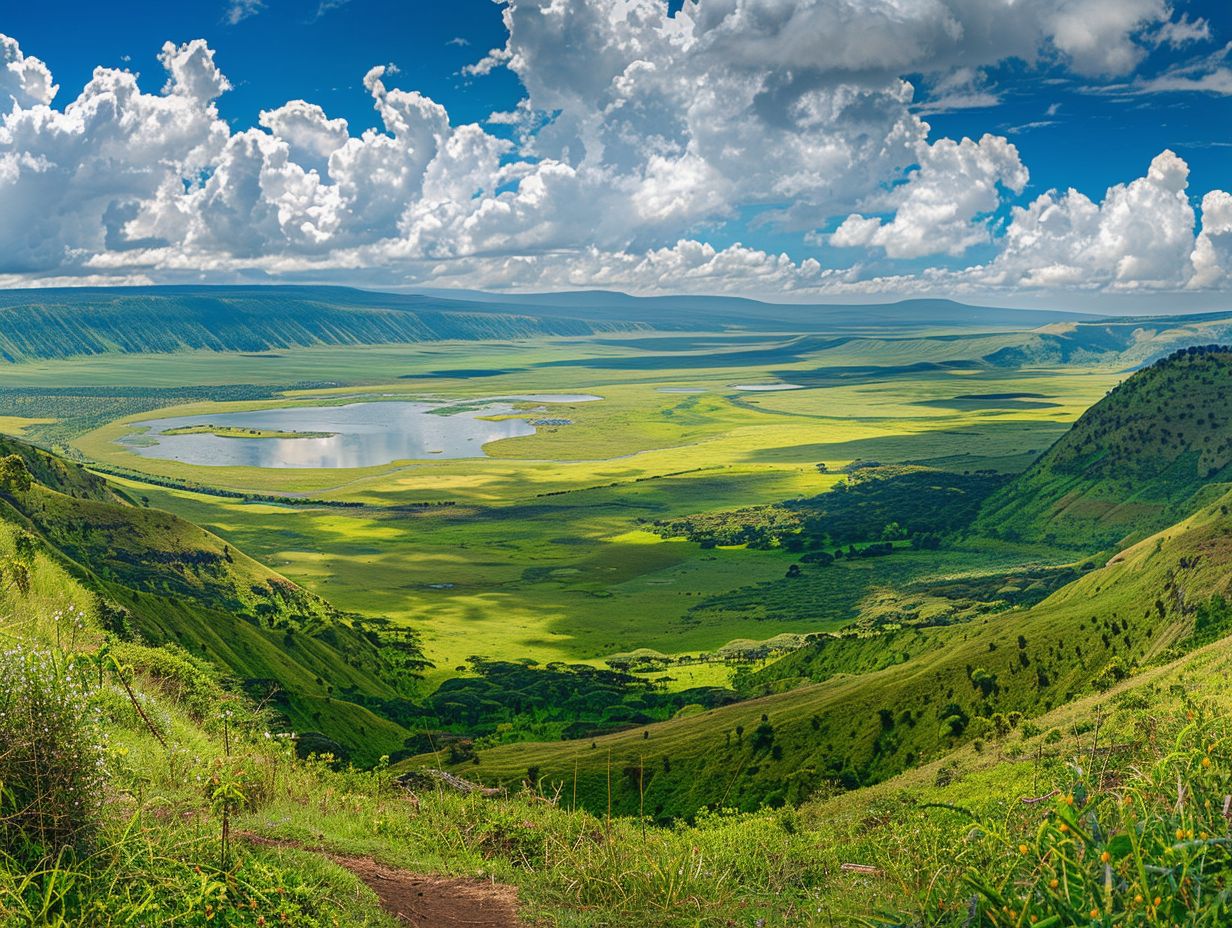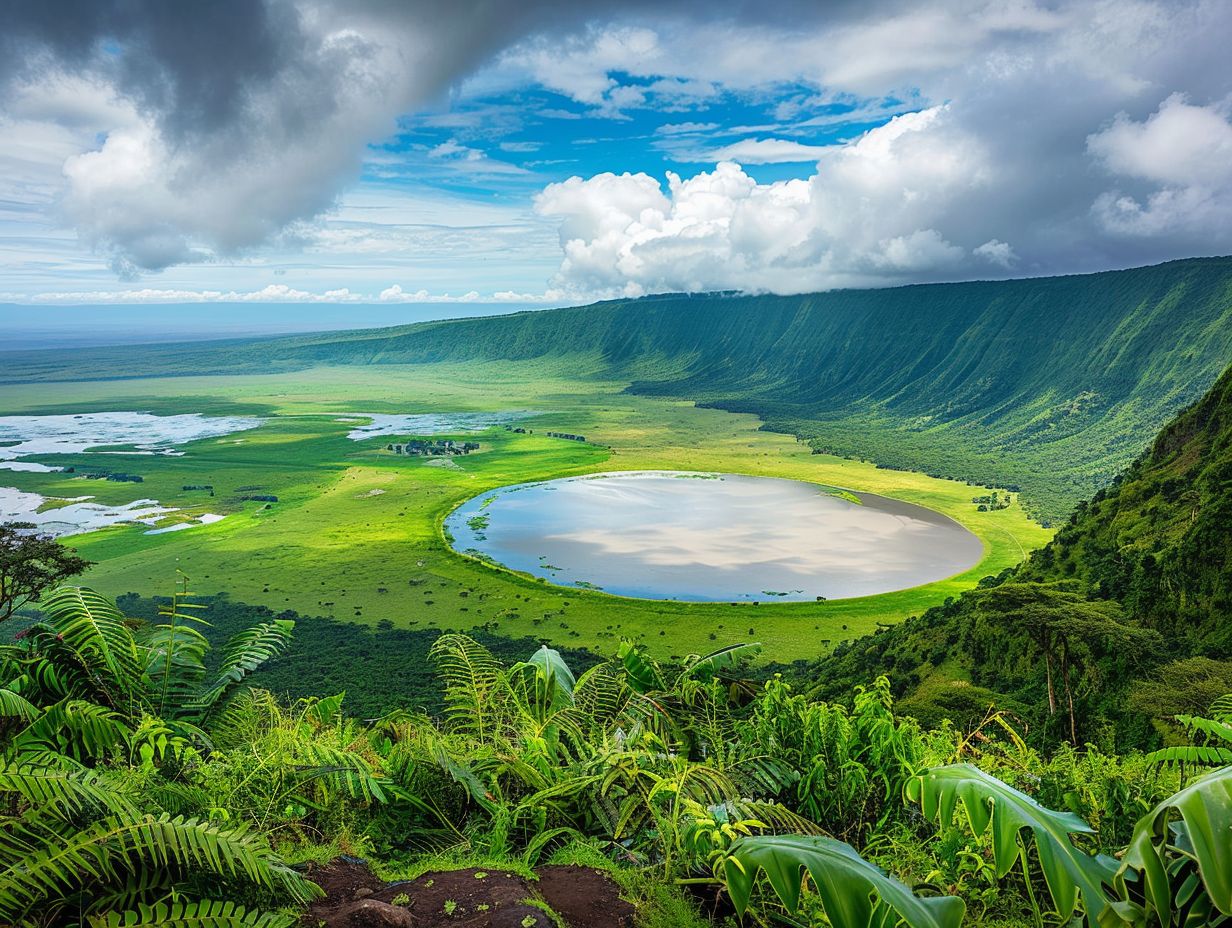
Ngorongoro Crater
Welcome to the ultimate guide to the Ngorongoro Crater! This article will take you on a journey through one of the most spectacular natural wonders in the world.
From its formation and geology to its climate and wildlife, we will explore everything you need to know about this unique ecosystem.
Whether you’re a nature enthusiast, a wildlife lover, or simply looking for your next travel destination, the Ngorongoro Crater has something for everyone. So sit back, relax, and let’s dive into the wonders of this magnificent place.
Key Takeaways:

- The Ngorongoro Crater is a large volcanic caldera located in Tanzania, Africa, known for its diverse wildlife and stunning scenery.
- The crater was formed over 2 million years ago and is home to a variety of animals, including the Big Five (lion, elephant, buffalo, leopard, rhinoceros).
- The best time to visit the Ngorongoro Crater is during the dry season (June-October) when wildlife is most active and the weather is pleasant for outdoor activities.
Where is the Ngorongoro Crater Located?
The Ngorongoro Crater is located in the Ngorongoro Conservation Area in northern Tanzania, near iconic landmarks such as the Serengeti National Park and Olduvai Gorge.
It is a UNESCO World Heritage Site known for its rich history and diverse ecosystems.
The Ngorongoro Crater, situated within the Great Rift Valley, is a breathtaking natural wonder encompassing a vast volcanic caldera that formed millions of years ago.
The crater’s walls reach heights of over 2,000 feet, creating a microcosm of diverse habitats ranging from lush forests to open savannah.
Given its remarkable biodiversity and archaeological significance, the Ngorongoro Crater holds great importance for researchers in the fields of geology and anthropology.
It stands as a testament to the intricate relationship between humans and the natural world throughout history.
What is the History of the Ngorongoro Crater?
The history of the Ngorongoro Crater dates back to ancient times when it was inhabited by the Maasai people, who coexisted with diverse wildlife species.
The nearby Olduvai Gorge is renowned for its archaeological significance, shedding light on human evolution and hominid species.
The Maasai people, known for their rich cultural heritage and warrior traditions, have a deep connection to the Ngorongoro Crater region.
Olduvai Gorge, often referred to as the ‘Cradle of Mankind,’ has been instrumental in shaping our understanding of human origins and the development of early civilizations.
What is the Geology of the Ngorongoro Crater?
The geology of the Ngorongoro Crater is characterized by its formation as a volcanic caldera millions of years ago, resulting in a unique landscape that supports a diverse array of habitats and ecosystems.
As one of the most significant calderas in the world, the Ngorongoro Crater’s rich volcanic history plays a pivotal role in shaping its environment.
The crater’s formation, following the collapse of a large volcano, has given rise to its distinctive circular shape and steep walls, creating a natural enclosure for its inhabitants.
This natural barrier has contributed to the preservation of diverse wildlife within the crater, including the iconic Big Five species – lions, elephants, buffalo, leopards, and rhinos.
The crater’s geological formations also influence its microclimates, supporting a plethora of plant species ranging from dense forests to grasslands, contributing to its unparalleled biodiversity.
What is the Formation of the Ngorongoro Crater?

The formation of the Ngorongoro Crater can be traced back to volcanic activity millions of years ago, where the collapse of a large volcano created the iconic caldera that we see today.
Volcanic eruptions played a crucial role in shaping the landscape of the area. As lava spewed out from the Earth’s mantle, it gradually built up the massive volcano over time.
The immense pressure under the surface eventually caused the volcano to collapse inwards, forming a vast depression known as a caldera.
This collapse is what gave rise to the unique circular shape of the Ngorongoro Crater, with its steep walls towering over the diverse ecosystems within.
The volcanic ash and rock deposits left behind by this event enriched the soil, creating fertile grounds that now support a wide array of flora and fauna.
What Types of Rocks are Found in the Ngorongoro Crater?
The Ngorongoro Crater is home to a variety of rock formations, including basalt flows, volcanic tuffs, and sedimentary layers that provide insights into the area’s geological history.
Basalt flows are prominent in the region, resulting from the solidification of lava over time, displaying characteristic columnar jointing.
Volcanic tuffs, on the other hand, reveal layers of volcanic ash and debris compressed into rock, reflecting explosive eruptions and periods of volcanic quiescence.
The sedimentary layers found within the crater serve as a record of environmental changes, such as ancient lakes or riverbeds, offering clues about the region’s past climate and habitats.
What is the Climate of the Ngorongoro Crater?
The climate of the Ngorongoro Crater is characterized by a mild and temperate climate due to its high elevation, with distinct dry and wet seasons that influence the wildlife and vegetation patterns in the area.
In the dry season, which typically spans from June to September, the Ngorongoro Crater experiences clear skies and cooler temperatures, ranging from 10 to 25 degrees Celsius.
Contrastingly, the wet season, occurring from November to May, brings occasional heavy rains, lush greenery, and higher humidity levels, with temperatures varying between 15 and 30 degrees Celsius.
The fluctuations in temperature and precipitation play a crucial role in shaping the diversity of plant life within the crater ecosystem.
The dry season prompts grasses to wither, exposing watering holes and leading herbivores to gather around these areas, attracting predators.
In contrast, the wet season revitalizes the vegetation, providing a rich food source for the animals, and the landscape transforms into a vibrant green oasis.
What is the Wildlife in the Ngorongoro Crater?
The Ngorongoro Crater boasts an incredible diversity of wildlife species, including the Big Five, as well as a multitude of other animals like zebras, wildebeest, and gazelles.
These majestic creatures roam freely in this natural paradise, creating a breathtaking spectacle for visitors lucky enough to witness their grace and power.
Apart from the well-known Big Five, the crater is also home to a rich array of bird species, from colorful flamingos to majestic eagles soaring through the sky.
The lush vegetation and varied landscapes within the crater support a delicate balance of ecosystems, contributing to its status as a UNESCO World Heritage Site.
Conservation efforts are vital in preserving this harmonious environment, ensuring the sustainability of these fascinating animal populations.
What Animals Can Be Found in the Ngorongoro Crater?
The Ngorongoro Crater is home to a wide array of wildlife species, including elephants, lions, cheetahs, hippos, and various antelope species, creating a rich and diverse ecosystem.
Among the notable inhabitants of the Ngorongoro Crater are the majestic elephants, known for their gentle yet powerful presence as they roam the savannah.
Lions, the iconic predators of the African plains, showcase their hunting prowess in this unique habitat. Cheetahs, with their unmatched speed and agility.
Hippos can be spotted cooling off in the crater’s water bodies, while various antelope species, such as impalas and gazelles, display their agility and grace as they navigate the grasslands.
What is the Migration Pattern of Animals in the Ngorongoro Crater?

The Ngorongoro Crater witnesses spectacular animal migrations, with herds of wildebeest, zebras, and gazelles moving in search of food and water.
During the dry season, these animals migrate towards the crater’s lush grasslands, while in the wet season, they move to higher plateaus to avoid flooding.
This cyclic movement not only serves the purpose of survival for the animals but also plays a crucial role in shaping the biodiversity of the region.
Migration routes have been established over generations, with each species knowing when and where to move, creating a harmonious dance of life within the crater.
What are the Activities and Attractions in the Ngorongoro Crater?
Visitors to the Ngorongoro Crater can enjoy a range of activities such as game drives, guided safaris, birdwatching, and cultural interactions with the Maasai people.
Embarking on a game drive through the Ngorongoro Crater presents an awe-inspiring opportunity to witness the spectacular wildlife that inhabits this UNESCO World Heritage Site.
The vast grasslands are home to diverse species like elephants, rhinos, lions, and hippos, creating an unforgettable safari experience.
Birdwatching enthusiasts will be delighted by the plethora of avian species that can be spotted around the crater.
For those seeking a deeper connection with the local culture, engaging in cultural interactions with the Maasai people offers a glimpse into their traditional way of life.
What Can Visitors Do in the Ngorongoro Crater?
Tourists in the Ngorongoro Crater can embark on thrilling safaris to observe the abundant wildlife, engage in birdwatching, and explore the diverse landscapes under the guidance of experienced tour operators.
Exploring the Ngorongoro Crater, visitors are often presented with unforgettable encounters with the magnificent Big Five – lions, elephants, buffalos, leopards, and rhinos – in their natural habitat.
The crater’s unique ecosystem provides a haven for a wide array of wildlife, including zebras, wildebeests, and hippos. Birdwatching enthusiasts will delight in spotting over 400 bird species.
What are the Must-See Sights in the Ngorongoro Crater?
Some of the must-see sights in the Ngorongoro Crater include the Lerai Forest, Ngoitokitok Spring, Empakaai Crater, and the stunning Lake Magadi, each offering unique perspective.
Among these attractions, the Lerai Forest stands out for its lush vegetation and diverse wildlife inhabitants, providing a serene setting for birdwatching and nature walks.
Ngoitokitok Spring, known for its crystal-clear waters and frequented by various animals, offers a picturesque spot for visitors to observe local wildlife up close.
Empakaai Crater, a hidden gem within the Ngorongoro Conservation Area, boasts a mesmerizing volcanic caldera filled with a deep blue lake, surrounded by picturesque greenery.
Lake Magadi’s vast salt flats and resident flamingos create a striking contrast against the backdrop of the crater walls, making it a hotspot for photographers and nature enthusiasts alike.
What are the Accommodation Options in the Ngorongoro Crater?
Accommodation options in the Ngorongoro Crater range from luxurious lodges and tented camps perched on the crater rim to cozy bush camps that immerse guests in the natural surroundings.
These diverse accommodation choices cater to a wide range of preferences and budgets, ensuring that every visitor can find their ideal retreat in this stunning location.
Luxurious lodges such as the iconic Ngorongoro Serena Safari Lodge offer opulent amenities, breathtaking views, and top-notch hospitality.
For those seeking a closer connection to nature, tented camps like Lemala Ngorongoro provide a unique blend of comfort and wilderness experiences.
Alternatively, bush accommodations like Sanctuary Ngorongoro Crater Camp offer a more intimate and rustic safari experience, perfect for adventurers.
What is the Best Time to Visit the Ngorongoro Crater?

The best time to visit the Ngorongoro Crater is during the dry season from June to September, when the weather is pleasant, wildlife viewing is optimal, and the crater landscapes are lush and vibrant.
During this period, the temperatures are moderate, ranging around 70-80 degrees Fahrenheit, making it comfortable for exploring the area while enjoying clear blue skies and minimal rainfall.
The dry season coincides with the Great Migration in the Serengeti, leading to a higher concentration of wildlife within the Ngorongoro Crater as animals gather around the water sources.
Visitors during this time are also likely to encounter the Big Five – lions, elephants, buffaloes, leopards, and rhinos – against the stunning backdrop of the crater’s picturesque scenery.
Frequently Asked Questions
1. What is Ngorongoro Crater?
A: Ngorongoro Crater is a large, volcanic caldera located in the Ngorongoro Conservation Area in Tanzania. It is often referred to as the “Garden of Eden” due to its unique ecosystem and diverse wildlife.
2. How was Ngorongoro Crater formed?
A: Ngorongoro Crater was formed over 2.5 million years ago when a large volcano erupted and collapsed, creating the caldera. Over time, the crater has filled with water and developed into a rich habitat for a variety of plant and animal species.
3. What animals can be found in Ngorongoro Crater?
A: Ngorongoro Crater is home to a diverse range of wildlife, including the “Big Five” – lions, elephants, buffalo, leopards, and rhinoceros. Other animals that can be found in the crater include wildebeests, zebras, hippos, and various bird species.
4. Can I visit Ngorongoro Crater on my own?
A: No, visitors are not allowed to enter Ngorongoro Crater on their own. All visits must be arranged and guided by a licensed safari operator. This is to ensure the conservation and protection of the area and its inhabitants.
5. When is the best time to visit Ngorongoro Crater?
A: The dry season, from June to October, is the best time to visit Ngorongoro Crater as the animals are easier to spot due to the lack of vegetation. However, the wet season, from November to May, offers lush scenery and the opportunity to see newborn animals.
6. What else can I do besides safari in Ngorongoro Crater?
A: Aside from safari, visitors can also participate in cultural activities such as visiting Maasai villages and learning about their traditional way of life. There are also opportunities for hiking and camping in the surrounding areas, as well as hot air balloon rides over the crater.